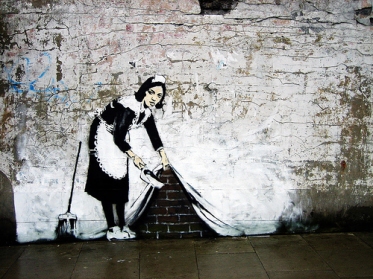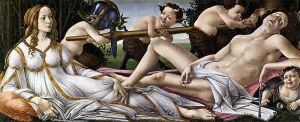Graffiti has been used by gangs, bored teenagers, and amateur artists practicing their style on the sides of train cars and walls. However, recently there seems to have been an outburst of professional graffiti artists that roam the streets manipulating common day objects, making a political jab, or simply creating an interest piece. Although technically these forms of art are illegal, it doesn’t make their art any less valid.
So welcome to the virtual gallery of graffiti where I will represent art from the well-known Banksy, Alexandre Orion, Swoon, and Mark Jenkins. I selected these artists to show the large variety of content and style f graffiti that is used. I could go on for days about the powerful social impact and liberating means for the artist graffiti has, but instead I think I’ll show the artists and let you do the thinking.
First off, I’m going to lead you through the Banksy collection to start out the exhibit.
Banksy is quite a famous graffiti artist, his style going from political jabs to humorous twists of reality. I guarantee you have seen some of his work before. Since these are graffiti artists, their identities are kept rather secretive, and Banksy is a master. Luckliy we do have some information. Banksy is a resident of the UK and started his brand of graffiti around 1992-1994 and has spread his art around the world. His style revolves around a stencil style of spray painting, a style first used for graffiti by Blek le Rat.

 “Graffiti Removal” Banksy
“Graffiti Removal” Banksy

Banksy

"Keep your coins, I want change" Banksy
I personally had a very hard time choosing so few pieces of art from Banksy as I am captivated by all of his work; however, I narrowed it down to one showing social commentary, a twist on reality, and political commentary. If you want to find yourself amused for hours, just do a simple google image search on Banksy and be amazed at the vast collection of art he had created.
Next, another style of graffiti is brought to us by a Brazillian artist that used what he called “Reverse Graffiti“. This artist I’m referring to is Alexandre Orion. Instead of creating damaging “vandalism” he created a mural of skulls in a tunnel by removing the caked on soot. So, In reality he was helping to clean the walls of the tunnel, he just chose to do it artistically. The city didn’t find it so amusing and power-washed the walls a few days later (video clip of him working).

"Reverse Graffiti" Alexandre Orion
Another popular means for an artist to get their message to the street is a style called wheat-pasting. This method allows an artist to work on the art on thin sheets of paper before applying it to the streets. Once the piece is ready to hang, the artist simply needs to run out and paste the picture to the surface like wallpaper ( another video showing the method).
I found one artist named Caledonia “Callie” Curry, who goes by the code name of “Swoon“, who’s main method is the wheat-paste method. She is based in Brooklyn in America and has been contributing her art to the streets since 1999. Her content isn’t political or social like what you would find with Banksy, hers is far more whimsical as you can see from the examples.

Swoon: Street Art

Swoon: In Berlin
Finally, there is one last medium of graffiti art that I found worthy of the exhibit, instillation art. This method is essentially the sculptor’s version of graffiti. The artist created three dimensional art around everyday objects that are found on the streets of a city. This method also seems to have become popular in advertising recently, but that’s a different story.
Mark Jenkins is an American artist from Virgina who currently is active in Washington DC. His art began appearing on the streets around 2003, mostly using packing take to create sculptures placed around the city. This included people, babies, horses, various other creatures all constructed out of tape.

Tape Giraffe

Meterpop

Tape Men
Once again, this was another artist that I had a hard time choosing so few pieces to represent. I encourage a simple google image search to see more if I have peaked your interest.
That is my exhibit representing the different styles, content, and variations of vandalism that we call art. I think graffiti is a fantastic way to send a message to the public and force them to re-think their everyday lives when it get broken up with such iconic art. Graffiti is a valuable freedom of expression in the art world and I hope it continues to create shock, awe, and confusion amidst the public.



















